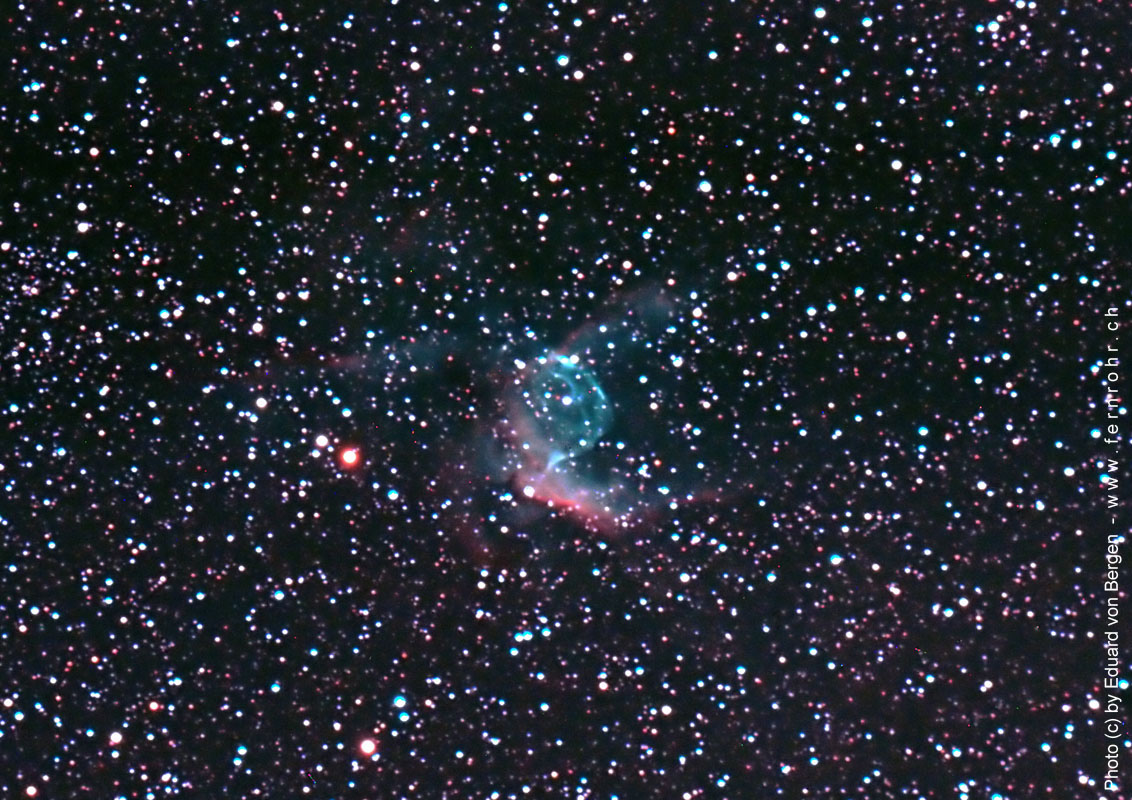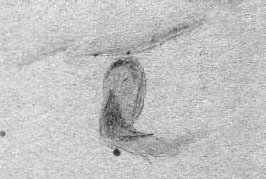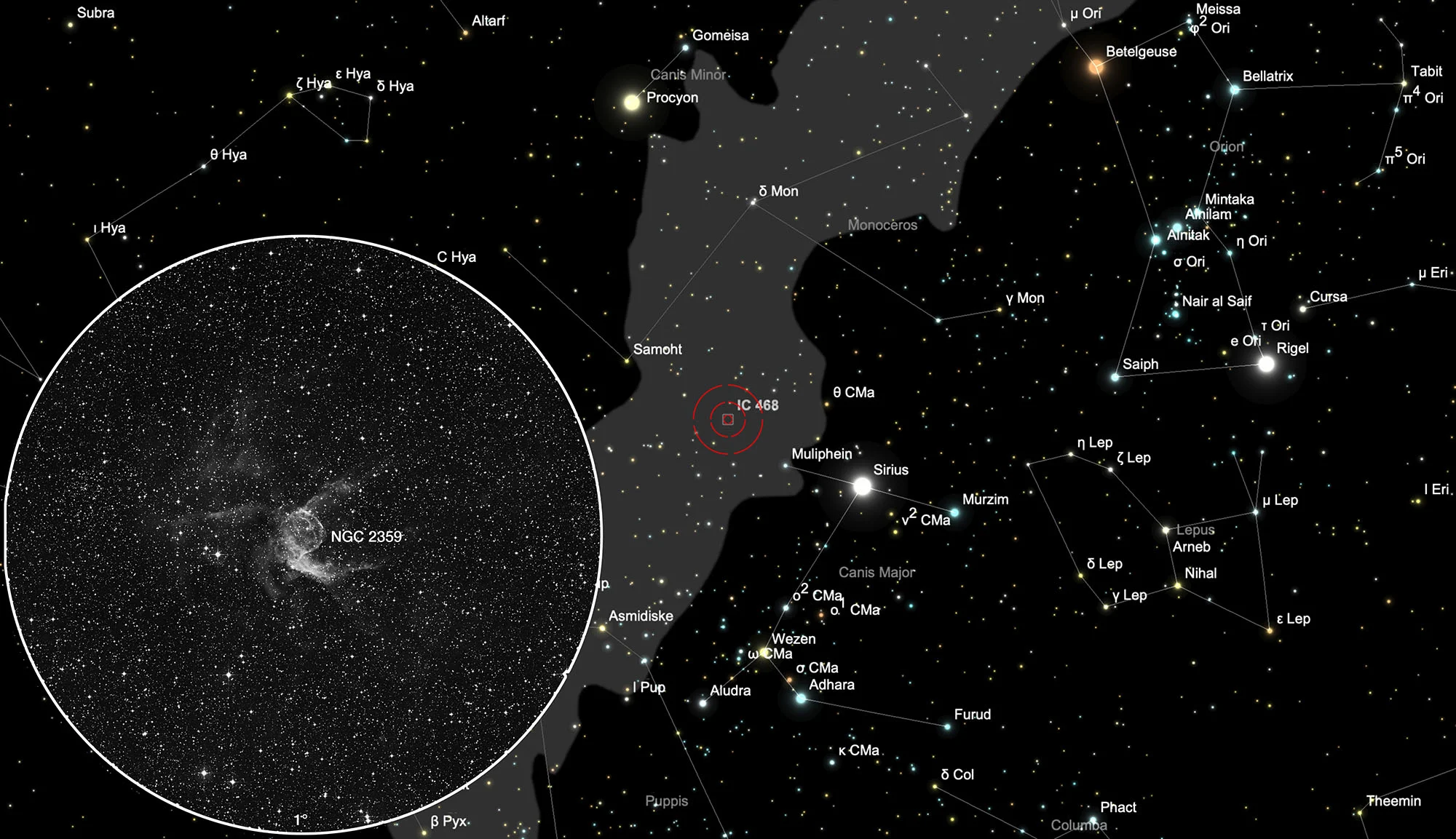Thor's Helmet, Duck Nebula (NGC 2359)


History
This odd nebula, known today as NGC 2359 was discovered on 31 January 1785 by William Herschel through his 18.7 inch reflector telescope. He cataloged it as V 21 and noted: «A broad extended nebulosity. Forms a parallelogram with a ray southwards; the parallelogram 8' long 6' broad very faint». [463]. Herschel's son John was reminded of a bust depicting the head and shoulders by the sight of the nebula.
The western part of this nebula is called IC 468 because it is much fainter than the rest and was therefore not discovered until 25 February 1887 by the French astronomer Guillaume Bigourdan and noted by Dreyer in the Index catalog in 1895 would. However, this IC number is usually neglected today. [277]

Physical Properties
It is an emission nebula around a 10.4 mag Wolf-Rayet star (WR). These stars are characterized by very high temperatures and an extremely strong mass loss due to stellar winds. As with the Bubble Nebula (NGC 7635) in the constellation Cassiopeia, a spherical gas bubble was also formed here by the strong stellar winds. When the dense stellar wind meets the surrounding interstellar medium, violent collisions and turbulence occur. Spectral analyzes also show that the nebula consists of a mixture of stellar wind matter and the interstellar medium.
| Name | RA | Dec | Type | vMag | Dim | MD | Dreyer Description | Identification, Remarks |
|---|---|---|---|---|---|---|---|---|
| NGC 2359 | 07 18 30.0 | -13 15 50 | EN | 11.5 | 6 × 4 | 3.670 | !!, vF, vvL, viF | WH V 21; h 3075; GC 1511; LBN 1041 |
| NGC 2361 | 07 18 23.7 | -13 12 32 | EN | 3.670 | vvF, vS | part of N 2359 | ||
| IC 468 | 07 17 18.9 | -13 13 07 | *3 | vF neby, perhaps 2 or 3 st inv |
How to find the Wolf-Rayet Nebula?
NGC 2359 lies in the northeastern part of Canis Maior. It is found on the Samoth (α Monocerotis) — Muliphein (γ Canis Majoris) junction, a third closer to Muliphein, between the two open star clusters NGC 2374 and NGC 2345. The nebula has about the same declination as these two star clusters and lies about on the eastern third closer to NGC 2374. The best viewing time is September to June.
Visual Observation
200 mm aperture: Without a filter, NGC 2359 reveals itself only as a faint, diffuse glow. But as soon as you mount an O-III filter, the object becomes a feast for the eyes! Around the 10.4 mag Wolf-Rayet star, the brighter area becomes visible at the edge of the gas bubble. There are also three «arms» that emanate from the edges of the bubble and give the nebula a peculiar appearance. — 1996, Philipp Reza Heck

300 mm aperture: The description of the object at 300 mm aperture is approximately the same as at 200 mm. The nebula is brighter with the larger aperture and the contrast of the nebula structures is stronger, so that finer details can be seen. The use of an O-III filter also brings a clear benefit here. — 1996, Stefan Meister
320 mm aperture: The nebula can only be made out faintly without a filter in a slightly hazy sky. However, it is sufficient to identify its position with certainty. With the O-III filter, the shape of the nebula emerges more clearly and you can see the shape of the helmet with the two wings. We couldn't agree on whether it was the helmet of Thor or the one of Asterix. — 5. 2. 2022, Ibergeregg, Stefans 320 mm f/5 Dobsonian, Bernd Nies
400 mm aperture: The nebula can be seen without a filter in the 21 mm Ethos eyepiece (85x). With the O-III filter, its round shape with the two horns comes out well. In the 16 mm Nagler (112x), light and dark areas can be seen in the nebula. One of the horns appears a little brighter. Edi thinks it looks like a Playboy bunny. — Taurus T400 f/4.5 Dobsonian, Hasliberg Reuti, 6. 11. 2021, Bernd Nies
762 mm aperture: The round central part of the Viking helmet NGC 2359 and the extension to an inverted six or to the Playboy bunny symbol can be seen without a nebula filter. With the O-III filter, the second horn of the Viking helmet also becomes clearly visible. The object can be seen most completely with the UHC filter, and a third faint extension can also be seen. — 30" f/3.3 Slipstream Dobsonian, Hasliberg Reuti, 5. 3. 2022, Eduard von Bergen
1000 mm aperture: In poor conditions (thin clouds, ice-cold violent Mistral) NGC 2359 appeared without a filter only as a diffuse, structureless nebula even in the 1m telescope of Puimichel. However, the use of an O-III filter changed everything: A high-contrast, green glowing nebula with an unbelievable wealth of structure was revealed! The view offered to us with a telescope aperture of one metre came very close to photographic images (see AAT image above). There was a bubble that got brighter at the edge and the bright WR star was in the centre. The «arms» emanating from the bubble showed an irregular distribution of brightness. — 1996, Philipp Reza Heck
